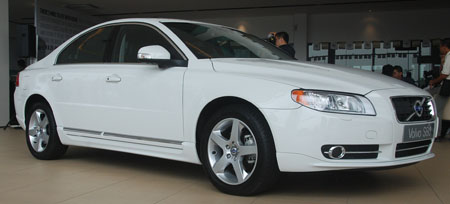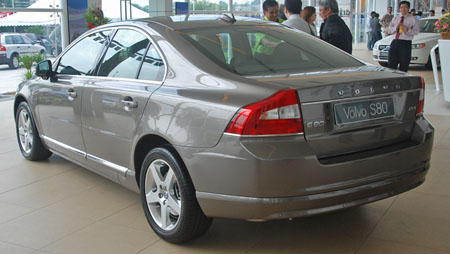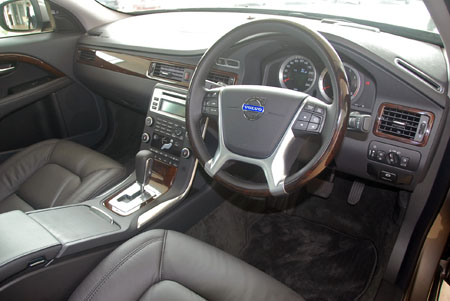
Volvo has unveiled the facelifted S80 this morning. No more CBU 3.2 model for Malaysia, but the locally assembled 2.5T variant lives on and has a lot more to offer than before, both under the hood and in equipment count, especially on the safety front.
The same turbocharged 2.5-litre five-cylinder engine is used, but with an extra 31 bhp and 40 Nm to make 231 bhp and 340 Nm available from 1,700 to 4,800 rpm. The substantial jump in figures is due to higher boost pressure, from the previous 0.5 bar to 0.8 bar. The added grunt results in improved performance; the 0-100 km/h sprint is completed in 7.5 seconds (previously 8.0 sec), leading Volvo to call its flagship “the fastest car in its class” (Volvo considers the E250 CGI and 523i as classmates).
Fuel consumption has improved as well, from 9.8 km/l to 10.4 km/l. Drive is channeled to the 17-inch front wheels via a six-speed automatic ‘box. Volvo also says that the “improved chassis” now offers “firmer handling”.

Unlike many CKD cars, this S80 is fully loaded with equipment, many of which weren’t available in the pre-facelift 2.5T. My favourite safety toy BLIS (Blind Spot Info System) is here, joined by Adaptive Cruise Control (ACC), which is similar to Mercedes’ Distronic.
Also here is Collision Warning and Auto Brake, which alerts the driver with audible and visual signals should he/she approach another vehicle’s rear end without braking (distracted by a hot pedestrian perhaps?). In such situations, the brakes are pre-charged and if the driver still does not react, the S80 automatically deploys 50% of brake capacity to reduce collision impact.
Next up is Driver Alert Control and Lane Departure Warning. LDW, as its name suggests, keeps you within the lines, while DAC monitors driver consistency, waking up sleepy or dozing drivers with a coffee sign on the meter. Just like in the W212 E-Class, but DAC goes further by having a mobile phone style signal bar for your concentration levels that’s always on display. Rounding it all up is active bending lights.

I have a thing for modern Volvo cabins and really like S80’s warm and cocooning living quarters. There are small changes here, namely ambient lighting from the doors, “silk metal trim” and a new four-spoke steering wheel with a full circle of tasteful dark wood (not just the top and bottom parts). For the exterior, blink and you’ll miss the changes.
A larger iron mark on the grille, eyeliner, a chrome strip along the bottom of the doors and below the rear lights are the subtle tweaks. Two new colours are available – Ice White and Ember Black – the latter has embedded “gold flakes” for an orangey hue in certain light conditions.
So how much? The price is up by RM10,000 to RM295,000 OTR without insurance, a tiny increase considering the extras you get over the pre-facelift car. Live pictures from this morning’s event is after the jump.
Volvo S80 facelift live images
[zenphotopress number=999 album=1124]
Volvo S80 facelift official images
[zenphotopress number=999 album=130]
Looking to sell your car? Sell it with Carro.












AI-generated Summary ✨
The comments reflect strong enthusiasm for the Volvo S80 2.5T facelift, highlighting its improved performance with increased horsepower and safety features, and emphasizing its value for money compared to German competitors. Many praise Volvo's safety reputation, build quality, and engineering, while some critique its pricing, maintenance costs, and driving dynamics, such as cornering stability. Several commenters express brand loyalty, viewing Volvo as a safe, reliable family car, and appreciate its understated design. There are mentions of comparative features and price against rivals like Mercedes and BMW, and a few discuss the subjective aspects like interior choices and resale value. Overall, the sentiment is predominantly positive, praising the upgrade, safety, and value proposition of the new S80.